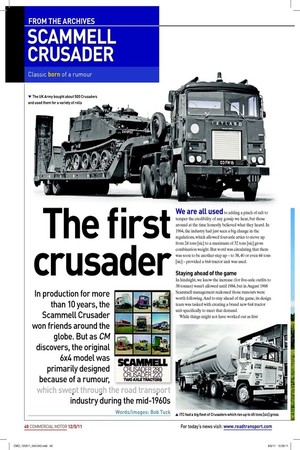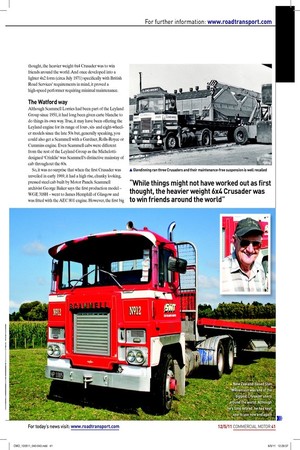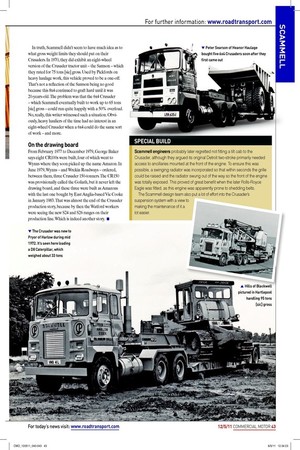The first crusader
Page 33

Page 34

Page 35

Page 36

If you've noticed an error in this article please click here to report it so we can fix it.
In production for more than 10 years, the Scammell Crusader won friends around the globe. But as CM
discovers, the original 6x4 model was primarily designed because of a rumour, which swept through the road transport industry during the mid-1960s
We are all used to adding a pinch of salt to temper the credibility of any gossip we hear, but those around at the time honestly believed what they heard. In 1964, the industry had just seen a big change in the regulations, which allowed four-axle artics to move up from 24 tons [sic] to a maximum of 32 tons [sic] gross combination weight. But word was circulating that there was soon to be another step up – to 38, 40 or even 44 tons [sic] – provided a 6x4 tractor unit was used.
Staying ahead of the game
In hindsight, we know the increase (for ive-axle outits to 38 tonnes) wasn’t allowed until 1984, but in August 1968 Scammell management reckoned those rumours were worth following. And to stay ahead of the game, its design team was tasked with creating a brand new 6x4 tractor unit speciically to meet that demand.
While things might not have worked out as irst thought, the heavier weight 6x4 Crusader was to win friends around the world. And once developed into a lighter 4x2 form (circa July 1971) speciically with British Road Services’ requirements in mind, it proved a high-speed performer requiring minimal maintenance.
The Watford way
Although Scammell Lorries had been part of the Leyland Group since 1951, it had long been given carte blanche to do things its own way. True, it may have been offering the Leyland engine for its range of four-, sixand eight-wheeler models since the late 50s but, generally speaking, you could also get a Scammell with a Gardner, Rolls-Royce or Cummins engine. Even Scammell cabs were different from the rest of the Leyland Group as the Michelottidesigned ‘Crinklie’ was Scammell’s distinctive mainstay of cab throughout the 60s.
So, it was no surprise that when the irst Crusader was unveiled in early 1969, it had a high rise, chunky looking, pressed steel cab built by Motor Panels. Scammell archivist George Baker says the irst production model – WGE 318H – went to James Hemphill of Glasgow and was itted with the AEC 801 engine. However, the irst big batch of 200 6x4s went for export and they had the Detroit GM 8V71 two-stroke engine driving through a Fuller range-change gearbox.
Scammell quickly realised the rumours to increase the C&U weight limits were simply rumours. And while the UK’s heavy haulage fraternity soon took to this new Scammell (Peter Searson’s Heanor Haulage bought ive of them), the Scammell dealers of Capital Motors and Arlington cancelled orders they had placed for 12 Crusaders each, as they also realised the heavier weight limit for 6x4s was never going to be allowed – in the short term at least.
Standard engine
However, its simply built concept caught the eye of Walter Batstone, the then engineering advisor for the BRS Group. And, with a bit of downsizing, he reckoned it was just the right thing for the business.
A lot of other BRS personnel were to have an input into the creation of the 4x2 Crusader, which was to have the Rolls-Royce Eagle 220, then the 280 (rather than the Detroit) as its standard engine.
George Baker’s records show that from November 1974 to March 1980 these 4x2s were built at the Guy factory in Wolverhampton and very few had sleeper cabs. Originally plated for 32 tons [sic] gross, the fourwheeler was subsequently rated for 40 tons [sic] gross operation. In truth, Scammell didn’t seem to have much idea as to what gross weight limits they should put on their Crusaders. In 1970, they did exhibit an eight-wheel version of the Crusader tractor unit – the Samson – which they rated for 75 tons [sic] gross. Used by Pickfords on heavy haulage work, this vehicle proved to be a one-off. That’s not a relection of the Samson being no good because this 8x4 continued to graft hard until it was 20-years-old. The problem was that the 6x4 Crusader – which Scammell eventually built to work up to 65 tons [sic] gross – could run quite happily with a 50% overload. No, really, this writer witnessed such a situation. Obviously, heavy hauliers of the time had no interest in an eight-wheel Crusader when a 6x4 could do the same sort of work – and more.
On the drawing board
From February 1977 to December 1979, George Baker says eight CR100s were built, four of which went to Wynns where they soon picked up the name Amazon. In June 1979, Wynns – and Wrekin Roadways – ordered, between them, three Crusader 150-tonners. The CR150 was provisionally called the Goliath, but it never left the drawing board, and these three were built as Amazons with the last one bought by East Anglia-based Vic Cooke in January 1983. That was almost the end of the Crusader production story, because by then the Watford workers were seeing the new S24 and S26 ranges on their production line. Which is indeed another story. ■












































